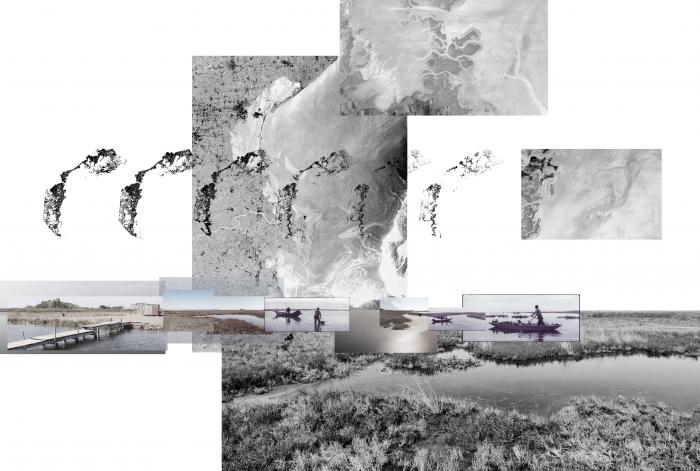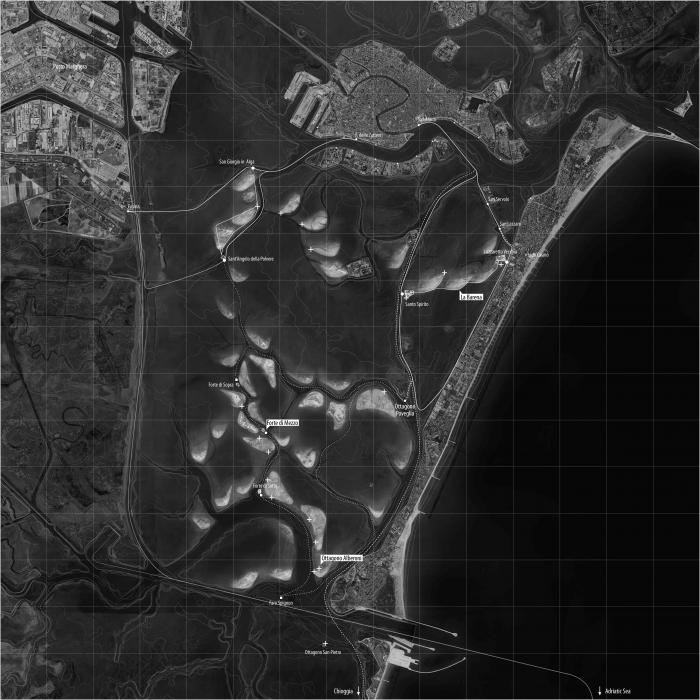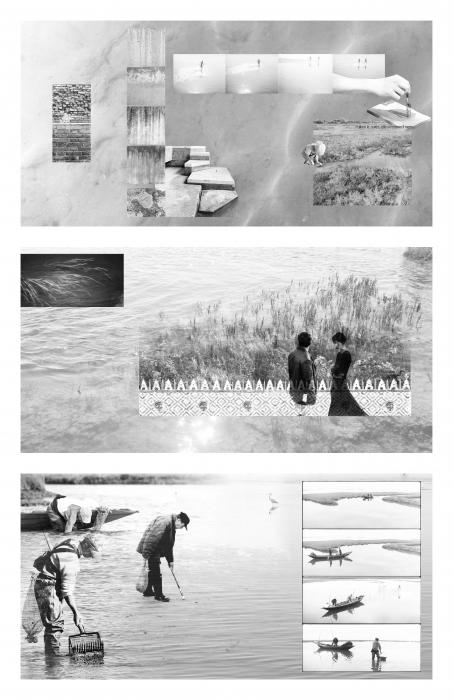I. SUMMARY INFORMATION
Project
269049
Status
Submitted
Award category
Preserved and transformed cultural heritage
You want to submit
NEW EUROPEAN BAUHAUS RISING STARS : concepts or ideas submitted by young talents (aged 30 or less)
Project title
The Agency of Barene
Full concept/idea title
A resilient landscape infrastructure for ecological, cultural, and productive heritage preservation
Description
Through the regeneration of the Venetian Lagoon brackish marshlands, the landscape project "The Agency of Barene'' seeks to mitigate the threats of relative sea-level rise by providing a nature-based flood defence, restore an endangered ecosystem, invest in alternative slow-tourisms and enrich local economic vibrancy. Simultaneously, it enriches and enhances the cultural image of the lagoon: the diffuse sense of horizontality, reflection and visibility conveyed by the unceasing surface of water.
Where is your concept/idea being developed or intended to be implemented in the EU?
Italy
Veneto
Laguna di Venezia
45.389186
12.299112
Venice
30100
II. DESCRIPTION OF THE PROJECT
Please provide a summary of your concept/ idea
Transitional territories such as lagoons are among the most impacted and delicate environments, threatened by the combined effects of climate change and human action. The research addresses the Venetian Lagoon hydromorphological sufferance, the state of neglect of its secondary islands, and the over-engineered flood defence design as crucial issues. From the research conducted, emerges clearly the need for redefining the role of the entire Venetian Lagoon in the next future, shifting its role from passive, exploited and damaged, to active, able to sustain resiliently the rest of its territory. To do so, the main strategy pursued is to reinforce the “barene” landscape, the brackish marshlands, fundamental for the hydromorphological, ecological and cultural survival of the lagoon.
Therefore, the goal of the project is to employ "The Agency of Barene" to mitigate the impact of anthropic and natural threats, acting as a nature-based flood defence (function), to recover hydromorphological sufferance (flow), and to support the cultural, ecological and productive heritage (form), making the Venetian Lagoon function as a sustaining landscape infrastructure. The barene, today suffering from fast rates of erosion, must act as pivotal means to achieve a comprehensive vision for the Venetian Lagoon where functions, flows, and forms are implemented and designed as part of a unique co-operating system.
Considering the natural forces present in the central lagoon (tides, winds, etc.), forty-four concave structures are designed in harmony with these forces, to capture suspended sediments, promoting accretion and becoming mature barene within 2050. The secondary islands of the central lagoon become the perceptive points from which experience the transformation and the growth of this new landscape. In the end, the intertwined system of barene and islands will produce a beneficial effect over the hydromorphological, ecological and biodiversity, and cultural surrounding environment.
Please give information about the key objectives of your concept/idea in terms of sustainability and how these would be met
Today, many are the perils threatening the correct functioning of the Venetian Lagoon: deepening of shallow seabed, general flattening and horizontal erosion, negative sediment balance, higher astronomic tides and faster tidal propagation, more powerful tidal currents and more frequent high water events. The restoration of the Ecological System of brackish marshlands would produce incredible hydromorphological benefits for the lagoon ecosystem. In fact, barene have a very high rate of CO2 sequestration; favour water exchange acting as expansion vessels limiting tidal impact, reducing wave power and speed, and mitigating strong winds; provide the Venetian Lagoon with protection against coastal flooding and erosion, attenuating wave transmission onshore. The amphibious landscape of barene, poised between land and water and covered by a thick bushy mantle, hosts numerous micro-environments characterized by salt-tolerant vegetation species and rich avifauna composition thanks to its abundant food resource.
The landscape research-by-design "The Agency of Barene" seeks to mitigate the threats of climate change and relative sea-level rise in the Venetian Lagoon; restore the correct hydraulic and morphologic functionalism; provide a nature-based flood defence through the application of Building-with-nature design principles. Furthermore, "The Agency of Barene" integrates the Cultural System of the abandoned secondary islands, opening it to light flows of local and external tourism, and provide space and useful means to support the local Productive system of lagoon fishing traditions and aquaculture activities.
The wider objective of the project is to reintroduce a “both-and” approach, in regards to Venice and its lagoon. If the city will invest in the correct functioning of the lagoon, implementing its infrastructure and protecting its precious mechanisms, the lagoon will be able to fulfil its ancient task of defence, flanked by a beneficial ecosystemic functioning.
Please give information about the key objectives of your concept/idea in terms of aesthetics and quality of experience beyond functionality and how these would be met
"The Agency of Barene" proposes within its framework the understanding and the design application of the "sense of lagoon”: a set of logics, rhythms, processes, time and spatial dimensions characterizing the Venetian Lagoon. Aesthetically, three formal characteristics defining the image of the lagoon landscape have been integrated into the project proposal: the concepts of horizontality, visibility, reflection. Therefore, through the project, the observer is accompanied in the experience of deepening the aesthetic character of the lagoon environment, on the muddy soils of the brackish marshlands.
Through the centuries, the Venetian Lagoon has weaved an extreme and profound relation with its horizon. Every single element (the brackish marshlands, the tree nurseries along the borders, the marbles of Venice, etc.) gets extremely dilated by the unceasing water surface. Therefore, every single vertical element is even more enhanced by this uniform condition spread until the eyes can reach. Closely related to the diffuse sense of horizontality is the radius of visibility, subjected to light and atmospheric conditions. Being the lagoon landscape defined by the linear distribution of its elements, the radius of visibility drastically changes as the elevation does. By boat, exploring this territory on the sea level, everything is immediate, almost graspable. By walking over the embankments along the borders of the lagoon, not more than +1.50 metres high, the horizon moves away by several hundred meters, unveiling the constant repetition of waters, slightly emerged pieces of land, islands and, again, waters. The reflective characteristic of water plays mysterious tricks, amplifying and exaggerating, even more, the objects reflected. Wooden poles (briccole) seem longer because their juncture point with the water is unexpectedly hidden, the islands, where vegetation has grown savagely, seem surrounded by floating gardens, and the sun rays seem to create highways of light.
Please give information about the key objectives of your concept/idea in terms of inclusion and how these would be been met
"The Agency of Barene", as part of its local heritage preservation program, directly supports traditional lagoon fishing activities. On the southern border of the central lagoon, the islands of Ottagono Alberoni and Ottagono San Pietro (built in XVI century to defend Venice from the Turkish threat, currently in an abandoned state), and the surrounding designed barene are implemented to support fishing activities (mussels and clams cultivation, open-water aquaculture, itinerant fishing, fry and juveniles' fishing), being the closest area to the inlet, where freshwater constantly flushes in and salinity concentration is very high. Here, the new barene will catch the majority of sediments coming in the lagoon from Malamocco inlet, they will become a rich breeding area for fauna and will function as a natural flourishing environment for fishing activities. The two islands will become accessible spots equipped to sustain anglers with necessary spaces, especially dry storages for boats and fishing gears.
Project construction, ordinary and extra-ordinary maintenance play an incisive role regarding the effective performances of the design proposal. Expert local labour is directly involved in the process. Construction consists of building the permanent structures (dykes) that will accumulate sediment and carefully planting perennial halophyte species as Sarcocornia fruticosa, Limonium narbonense and Juncus maritimus. Ordinary maintenance occurs every 6-12 months, concerning at the same time both the image of the intervention (conservation) and the functioning (structural efficiencies). It is intended to be carried out by local fishermen, anglers, and workers, equipped with adequate means of transportation and working tools, but especially with territorial and geographical knowledge. Extra-ordinary maintenance will occur after powerful and unexpected natural events (heavy swells, thunderstorms, extreme acqua alta, etc.), and consist of checking on the structural efficiency.
Please explain the innovative character of your concept/ idea
At the very core of the "The Agency of Barene" lies the idea that landscapes, and specifically the Venetian Lagoon, must be intended and addressed as flowscapes: they are the continuous and ever-mutating result of multiple flows' interaction (for example sand, water, air, goods, people, transportation, data, etc.); as such, these flows needs to be accommodated working with nature, not opposing it, through landscape design and territorial planning, to restore endangered ecosystems. To achieve this, within the scope of the research, "Building-with-Nature" technical design principles have been applied in combination with landscape architecture planning perspectives: not only for a resilient and restored natural environment "per se" (functioning correctly from the hydromorphological perspective, able to mitigate climate change and relative sea-level rise) but also a comfortable living environment, where the human being is the thoughtful perceiver of the landscape, which exists because it is observed and thought by someone. The "Building-with-Nature" approach is employed as a catalyst for the coexistence of resilient water protection systems and strong ecological structures; at the same time, its implementation is coordinated with the creation of a human-scale leisure network located in the central lagoon and the direct support of the traditional fishing activities.
The application of the "Building-with-Nature" approach through the lens of landscape architecture employs the agency of barene landscape to attract and intensify biodiversity rates in the central lagoon, to provide a nature-based flood defence system, and recover and improve environmental efficiency, making the Venetian Lagoon a sustaining physical and cultural landscape infrastructure.
The lagoon, if protected and safeguarded after these last decades of neglect and exploitation, can become the active subject protecting all the territory that surrounds it.
Please detail the plans you have for the further development, promotion and/or implementation of your concept/idea, with a particular attention to the initiatives to be taken before May 2022
“The Agency of Barene”, as well as being selected as Best Graduation Thesis 2020 of the Faculty of Architecture of Delft Technical University (the Netherlands), has been presented at the International Conference on Sustainable Development 2020 in the panel Nature-Based Solutions to Climate Change, at IUAV University of Venice and Politecnico di Milano, and recently included within Ocean Space and TBA21-Academy public program “Lagoon Micro-ecologies. Venice as a model for the future?” in Venice, Italy.
By May 2022, from a theoretical point of view, the goal would be to expand the bibliography to refine the hypotheses and conclusions of the thesis presented, especially in relation to the naval transport infrastructure and the economic system of Porto Marghera (the commercial harbour of Venice). In fact, the relationship between the project proposal and the lagoon port is the most delicate one to be addressed. At the same time, deepening, even more, the research about water fluxes and tides and sediment transportation and balance in the Venetian Lagoon will consolidate the basis for technical and applicative progress: the development of hydrodynamic models to simulate the project entries to test effectively their potential benefits. The models’ development will provide functioning insights able to directly influence and modify the designed barene configuration. Both these goals, theoretical and practical, are meant to be achieved within the panorama of a PhD program at IUAV University of Venice and the participation in TBA-21 Academy Residency 2021.
Alongside the progress of the contents, the promotion, diffusion and discussion of the ongoing research work are programmed through the active participation in conferences and public programs, in Italy and internationally.
III. UPLOAD PICTURES
IV. VALIDATION
By ticking this box, you declare that all the information provided in this form is factually correct, that the proposed concept/idea has not been proposed for the New European Bauhaus Rising Stars Awards more than once in the same category.
Yes



